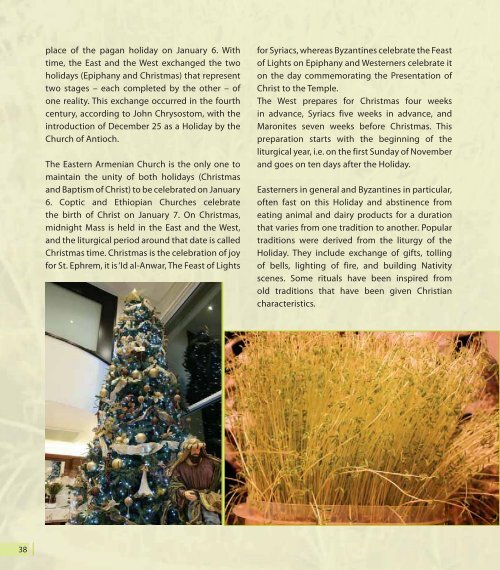Cultural aspects in Christian and Islamic religions - unesdoc - Unesco
Cultural aspects in Christian and Islamic religions - unesdoc - Unesco
Cultural aspects in Christian and Islamic religions - unesdoc - Unesco
Create successful ePaper yourself
Turn your PDF publications into a flip-book with our unique Google optimized e-Paper software.
38<br />
place of the pagan holiday on January 6. With<br />
time, the East <strong>and</strong> the West exchanged the two<br />
holidays (Epiphany <strong>and</strong> Christmas) that represent<br />
two stages – each completed by the other – of<br />
one reality. This exchange occurred <strong>in</strong> the fourth<br />
century, accord<strong>in</strong>g to John Chrysostom, with the<br />
<strong>in</strong>troduction of December 25 as a Holiday by the<br />
Church of Antioch.<br />
The Eastern Armenian Church is the only one to<br />
ma<strong>in</strong>ta<strong>in</strong> the unity of both holidays (Christmas<br />
<strong>and</strong> Baptism of Christ) to be celebrated on January<br />
6. Coptic <strong>and</strong> Ethiopian Churches celebrate<br />
the birth of Christ on January 7. On Christmas,<br />
midnight Mass is held <strong>in</strong> the East <strong>and</strong> the West,<br />
<strong>and</strong> the liturgical period around that date is called<br />
Christmas time. Christmas is the celebration of joy<br />
for St. Ephrem, it is ‘Id al-Anwar, The Feast of Lights<br />
for Syriacs, whereas Byzant<strong>in</strong>es celebrate the Feast<br />
of Lights on Epiphany <strong>and</strong> Westerners celebrate it<br />
on the day commemorat<strong>in</strong>g the Presentation of<br />
Christ to the Temple.<br />
The West prepares for Christmas four weeks<br />
<strong>in</strong> advance, Syriacs five weeks <strong>in</strong> advance, <strong>and</strong><br />
Maronites seven weeks before Christmas. This<br />
preparation starts with the beg<strong>in</strong>n<strong>in</strong>g of the<br />
liturgical year, i.e. on the first Sunday of November<br />
<strong>and</strong> goes on ten days after the Holiday.<br />
Easterners <strong>in</strong> general <strong>and</strong> Byzant<strong>in</strong>es <strong>in</strong> particular,<br />
often fast on this Holiday <strong>and</strong> abst<strong>in</strong>ence from<br />
eat<strong>in</strong>g animal <strong>and</strong> dairy products for a duration<br />
that varies from one tradition to another. Popular<br />
traditions were derived from the liturgy of the<br />
Holiday. They <strong>in</strong>clude exchange of gifts, toll<strong>in</strong>g<br />
of bells, light<strong>in</strong>g of fire, <strong>and</strong> build<strong>in</strong>g Nativity<br />
scenes. Some rituals have been <strong>in</strong>spired from<br />
old traditions that have been given <strong>Christian</strong><br />
characteristics.

















